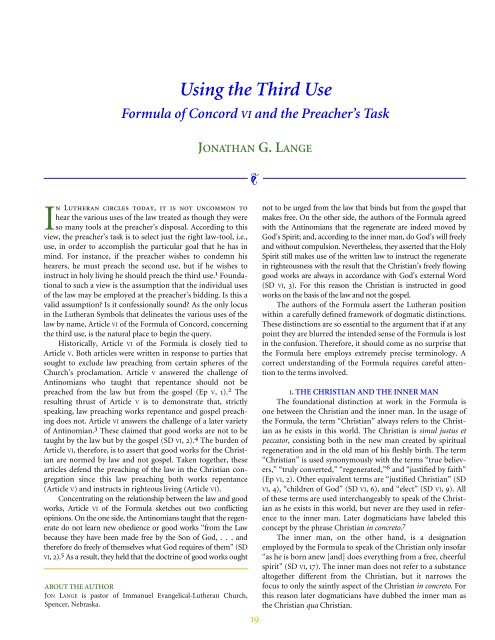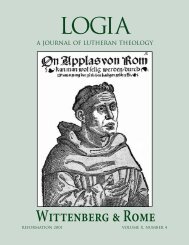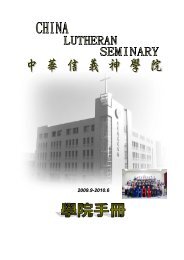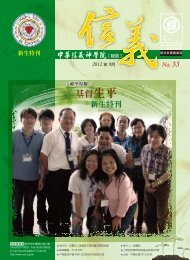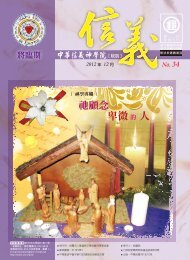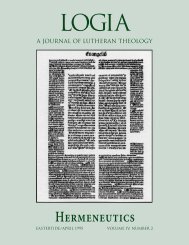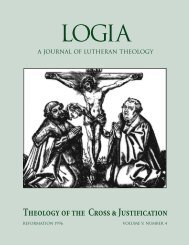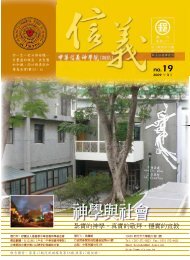03-1 Pastoral Care.pdf
03-1 Pastoral Care.pdf
03-1 Pastoral Care.pdf
- No tags were found...
You also want an ePaper? Increase the reach of your titles
YUMPU automatically turns print PDFs into web optimized ePapers that Google loves.
Using the Third UseFormula of Concord VI and the Preacher’s TaskJONATHAN G. LANGEIN LUTHERAN CIRCLES TODAY, IT IS NOT UNCOMMON TOhear the various uses of the law treated as though they wereso many tools at the preacher’s disposal. According to thisview, the preacher’s task is to select just the right law-tool, i.e.,use, in order to accomplish the particular goal that he has inmind. For instance, if the preacher wishes to condemn hishearers, he must preach the second use, but if he wishes toinstruct in holy living he should preach the third use. 1 Foundationalto such a view is the assumption that the individual usesof the law may be employed at the preacher’s bidding. Is this avalid assumption? Is it confessionally sound? As the only locusin the Lutheran Symbols that delineates the various uses of thelaw by name, Article VI of the Formula of Concord, concerningthe third use, is the natural place to begin the query.Historically, Article VI of the Formula is closely tied toArticle V. Both articles were written in response to parties thatsought to exclude law preaching from certain spheres of theChurch’s proclamation. Article V answered the challenge ofAntinomians who taught that repentance should not bepreached from the law but from the gospel (Ep V, 1). 2 Theresulting thrust of Article V is to demonstrate that, strictlyspeaking, law preaching works repentance and gospel preachingdoes not. Article VI answers the challenge of a later varietyof Antinomian. 3 These claimed that good works are not to betaught by the law but by the gospel (SD VI, 2). 4 The burden ofArticle VI, therefore, is to assert that good works for the Christianare normed by law and not gospel. Taken together, thesearticles defend the preaching of the law in the Christian congregationsince this law preaching both works repentance(Article V) and instructs in righteous living (Article VI).Concentrating on the relationship between the law and goodworks, Article VI of the Formula sketches out two conflictingopinions. On the one side, the Antinomians taught that the regeneratedo not learn new obedience or good works “from the Lawbecause they have been made free by the Son of God, . . . andtherefore do freely of themselves what God requires of them” (SDVI, 2). 5 As a result, they held that the doctrine of good works oughtABOUT THE AUTHORJON LANGE is pastor of Immanuel Evangelical-Lutheran Church,Spencer, Nebraska.19not to be urged from the law that binds but from the gospel thatmakes free. On the other side, the authors of the Formula agreedwith the Antinomians that the regenerate are indeed moved byGod’s Spirit; and, according to the inner man, do God’s will freelyand without compulsion. Nevertheless, they asserted that the HolySpirit still makes use of the written law to instruct the regeneratein righteousness with the result that the Christian’s freely flowinggood works are always in accordance with God’s external Word(SD VI, 3). For this reason the Christian is instructed in goodworks on the basis of the law and not the gospel.The authors of the Formula assert the Lutheran positionwithin a carefully defined framework of dogmatic distinctions.These distinctions are so essential to the argument that if at anypoint they are blurred the intended sense of the Formula is lostin the confusion. Therefore, it should come as no surprise thatthe Formula here employs extremely precise terminology. Acorrect understanding of the Formula requires careful attentionto the terms involved.I. THE CHRISTIAN AND THE INNER MANThe foundational distinction at work in the Formula isone between the Christian and the inner man. In the usage ofthe Formula, the term “Christian” always refers to the Christianas he exists in this world. The Christian is simul justus etpeccator, consisting both in the new man created by spiritualregeneration and in the old man of his fleshly birth. The term“Christian” is used synonymously with the terms “true believers,”“truly converted,” “regenerated,” 6 and “justified by faith”(Ep VI, 2). Other equivalent terms are “justified Christian” (SDVI, 4), “children of God” (SD VI, 6), and “elect” (SD VI, 9). Allof these terms are used interchangeably to speak of the Christianas he exists in this world, but never are they used in referenceto the inner man. Later dogmaticians have labeled thisconcept by the phrase Christian in concreto. 7The inner man, on the other hand, is a designationemployed by the Formula to speak of the Christian only insofar“as he is born anew [and] does everything from a free, cheerfulspirit” (SD VI, 17). The inner man does not refer to a substancealtogether different from the Christian, but it narrows thefocus to only the saintly aspect of the Christian in concreto. Forthis reason later dogmaticians have dubbed the inner man asthe Christian qua Christian.


